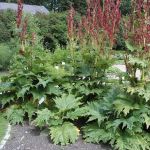| Common Name: |
Chinese Rhubarb |
| Other Names: |
Chinghai Rhubarb |
| Botanical Name: |
Rheum palmatum |
| Genus: |
Rheum |
| Family: |
Polygonaceae |
| Native Location: |
NW China and NE Tibet |
| Cultivation: |
Well-drained, moist, rich soil in sun. |
| Propagation: |
By seed sown in autumn (species and varieties only); by division in early spring. |
| Harvest: |
Rhizomes are lifted in autumn from plants at least three years old and dried for use in decoctions, dry extracts, powders, tinctures, and tablets. |
| Variations: |
Atrosanquineum
Syn. Atropurpureum
Has bright red buds, red-purple young leaves, and cherry-red flowers followed by pink fruits. |
Var. tanguticum
Has jagged leaves, red-green when young, and white, pink, or red flowers.
Height: 2m (6ft) |
|
| Height: |
2.5m (8ft) |
| Width: |
1.8m (6ft) |
| Hardiness: |
Z5-8 |
| Parts Used: |
Rhizomes (da huang) |
| Properties: |
A bitter, astringent, cooling herb that improved digestion, stimulates the uterus, promotes healing, and has a laxative effect. |
| Medicinal Uses: |
Internally for chronic constipation, diarrhea, liver and gall bladder complaints, hemorrhoids, menstrual problems, heat-related symptoms (such as nosebleed), and skin eruptions due to the accumulation of toxins. Externally for burns. Used in Homeopathy for irritability and teething in children. |
| Warning: |
Leaves are harmful if eaten.
Contraindicated during pregnancy and lactation, and for intestinal obstruction. |
| Bibliography: |
Encyclopedia of Herbs by Deni Brown Copyright © 1995, 2001 Dorling Kindersley Limited Pp 343-344 |
